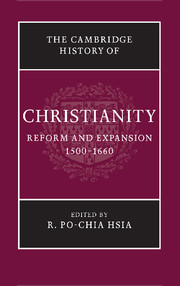Book contents
- Frontmatter
- Part I Luther and the Holy Roman Empire
- Part II The Second Reformation
- Part III Catholic Renewal
- Part IV Resolving Confessional Conflicts
- Part V Religion, Society, and Culture
- Part VI Christianity and Other Faiths
- 26 Christianity and Judaism
- 27 The naturalization of Andean Christianities
- 28 Between Islam and Orthodoxy: Protestants and Catholics in south-eastern Europe
- 29 Christianity shaped by the Chinese
- 30 Reception of Hinduism and Buddhism
- Bibliography
- Index
- References
26 - Christianity and Judaism
from Part VI - Christianity and Other Faiths
Published online by Cambridge University Press: 28 March 2008
- Frontmatter
- Part I Luther and the Holy Roman Empire
- Part II The Second Reformation
- Part III Catholic Renewal
- Part IV Resolving Confessional Conflicts
- Part V Religion, Society, and Culture
- Part VI Christianity and Other Faiths
- 26 Christianity and Judaism
- 27 The naturalization of Andean Christianities
- 28 Between Islam and Orthodoxy: Protestants and Catholics in south-eastern Europe
- 29 Christianity shaped by the Chinese
- 30 Reception of Hinduism and Buddhism
- Bibliography
- Index
- References
Summary
A population map of the Jews in Christian lands in the year 1500 would reveal a striking fact – namely, that in vast areas of Christendom there were no Jews. Practising Jews were permitted to live in only three regions of Europe: the Italian states, the Holy Roman Empire, and Poland-Lithuania. (Even in these regions, they were excluded from many towns and principalities.) Beyond these areas, Jewish life existed only clandestinely, mainly in Spain and Portugal, where members of a population of unwilling converts to Catholicism practised crypto-Judaism.
Where Jewish settlement was permitted, insecurity was a reality of everyday life. Jewish communities were organized as autonomous corporate entities, and did enjoy basic protections, but their members were burdened with numerous restrictions and special taxes. The socio-cultural environment was dominated by images and rituals that conveyed hostility to Jews and Judaism (and evoked a hostile response in Jews themselves). Periodically, the equilibrium was broken by a paroxysm of popular anti-Jewish fury, stirred by clerical incitement or false accusations of ritual crimes. Local expulsions were common. In general, only Christian dependence on the Jews’ economic services ensured the Jews’ continued right to settlement.
Between 1500 and 1660, patterns of Christian–Jewish interaction were profoundly impacted by two major transformations: humanism and the Reformation, on the one hand, and the rise of the Atlantic state-system, on the other. This chapter will focus on changing patterns of Christian–Jewish interaction in the religious sphere, while keeping in mind the political and economic context.
Over the entire period, the largest Jewish population in Europe was that of Poland-Lithuania. (By 1660, it numbered perhaps 300,000 persons.) By the late medieval period it had become a refuge for Jews fleeing persecutions in central Europe.
- Type
- Chapter
- Information
- The Cambridge History of Christianity , pp. 483 - 503Publisher: Cambridge University PressPrint publication year: 2007



